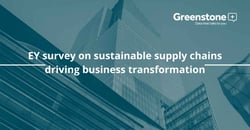EY survey on sustainable supply chains driving business transformation
 EY recently released a survey on 'Building supply chain sustainability that can drive revenues and reduce operational risks'. This survey of senior supply chain executives shows the need for a holistic and ROI-backed roadmap to meet sustainability performance goals.
EY recently released a survey on 'Building supply chain sustainability that can drive revenues and reduce operational risks'. This survey of senior supply chain executives shows the need for a holistic and ROI-backed roadmap to meet sustainability performance goals.
- EY teams surveyed 525 executives about their sustainable supply chain practices. Many have long-term strategies but struggle to measure their progress.
- Business case initiatives for sustainability stretch beyond cost savings to increased revenue, customer loyalty and share price.
- To reap the benefits now and in the long term, companies should align to science-based targets and begin work to define and achieve those goals.
Below is a summary of the key findings of the EY teams 2022 survey:
1. Despite a long-term vision, organisations struggle with a lack of visibility and ROI backed sustainability initiatives
EY teams 2022 survey reveals that visibility throughout the supply chain is this year’s top priority for supply chain executives, having been a top-two priority for them in 2021 and 2019. Further, there is a critical need for executives to assess risks, plan for disruptions, and even better, to avoid them. And although increased end-to-end supply chain visibility is a top priority, it remains a work in progress—only about four in 10 respondents (37%) have seen increasing visibility.
In one notable finding, EY teams research revealed that 33% of companies lack a business case for sustainable supply chains and nearly half of respondents said their companies are struggling to measure the return on sustainable supply chain activities. A lack of business case to support expenditures and processes to track sustainability improvements may stall funding support for future initiatives.
2. A sustainable supply chain roadmap looks beyond procurement toward end-to-end supply chain transformation
Cost savings and efficiency were cited as the top motivators for embarking on supply chain sustainability by 61% of companies. However, financial performance is not the only benefit to expect.
As a result of their ESG initiatives, 55% of supply chain executives say they expect to see better management of operational risks within the next one to three years, adding to the 20% who have already seen these reductions.
While 31% have already experienced enhanced efficiency and productivity, 51% expect to see that in the next one to three years. In the longer term, three to five years, 54% of respondents expect increased share price or other indicators of shareholder value.
3. Companies should play the long game but start their supply chain sustainability initiatives now
While supply chain sustainability goals will look different for each company, EY teams offer five actions to get started.
- Determine how sustainable supply chains fit into your organisational-wide commitments and goals to help prioritise your efforts. EY teams recommend first looking at organisation materiality, supplier risk assessments and organisational commitment, for example science-based target (SBT) activation, supplier diversity, human rights, etc., and then determining which goals the supply chain activates.
- Improve the visibility and traceability of your supply chain.
Deploy technological capabilities to help improve Tier-n visibility and supplier engagement. Communicate often with stakeholders through broader data sharing and collaboration tools. - Expand your ROI measurement to include intangible impacts and sustainability outcomes.
Think about business-case drivers beyond cost savings, including revenue, market share, reduced risk and improved customer and employee loyalty. - Move beyond a sourcing and procurement focus to capture benefits across the end-to-end supply chain. Enterprises should take an end-to-end approach, including planning, sourcing, manufacturing, and logistics and distribution. Cross-functional collaboration with other functions such as finance, risk and more can broaden opportunities for business benefits.
- Leverage available tax incentives and grants.
Review your sustainability initiatives for cost benefits and tax impact. Only 11% of companies are looking to tax incentives, grants and rebates to fund their programs.
For more information on this survey and to download the full report, please visit the 'Building supply chain sustainability that can drive revenues and reduce operational risks', 2022 webpage.
Visit our Supply chain & responsible sourcing content library aiming to keep you informed with the latest industry updates and enable sustainability and supply chain professionals to understand the impacts and improve the transparency, of their supply chains.
To speak to one of the Greenstone team about how Greenstone's award-winning software and supporting services can help support and improve your organisation's sustainability reporting strategy, talk to us.









